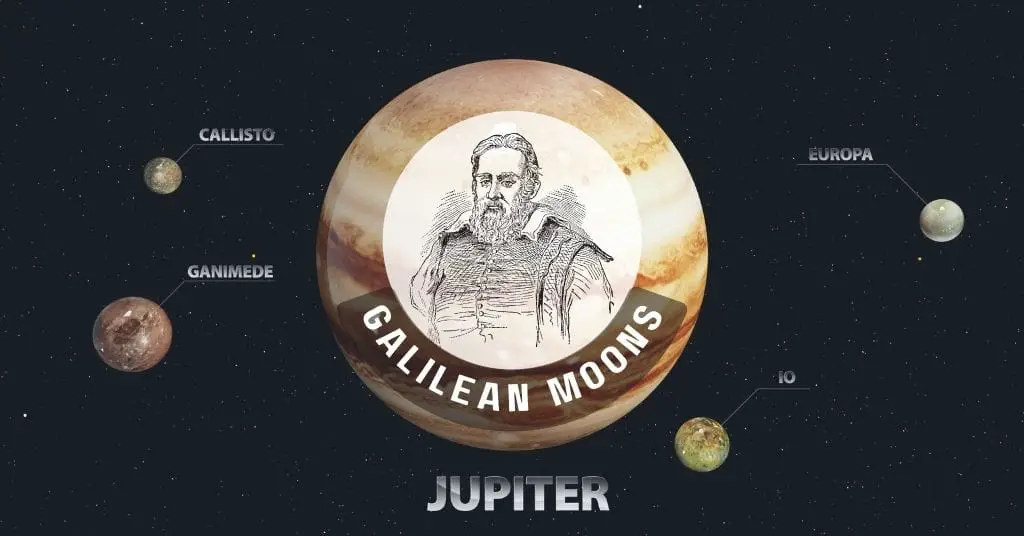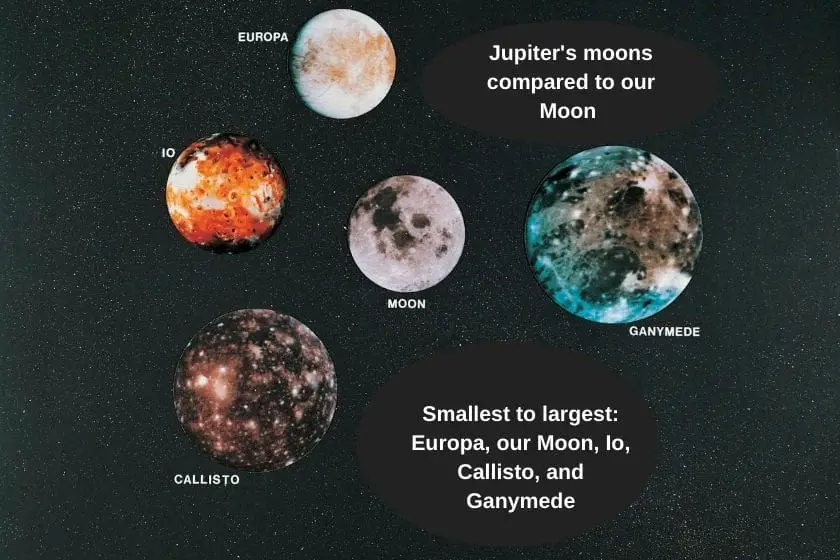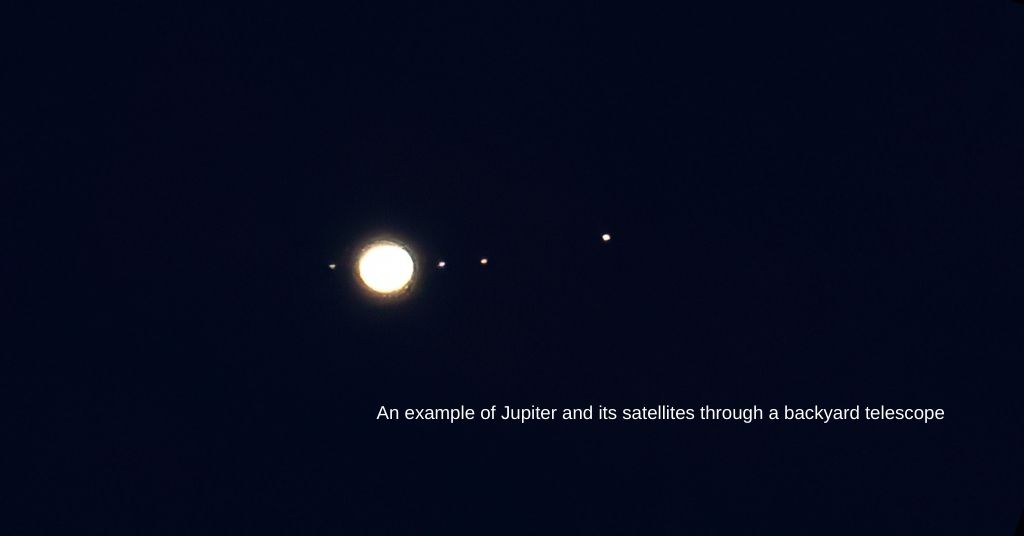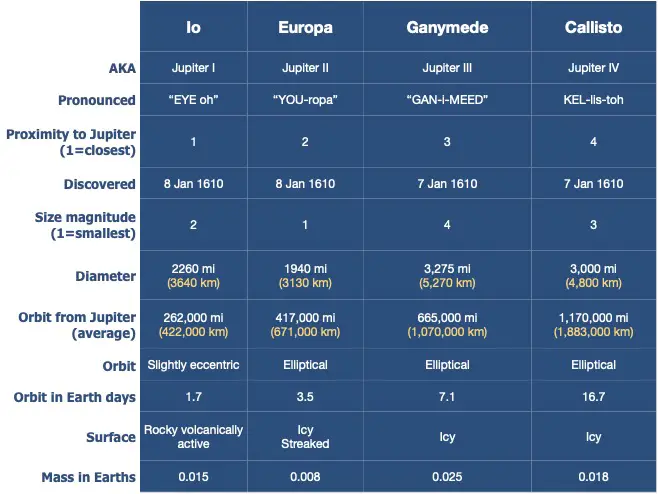Are you observing Jupiter’s moons or aiming to, and are wondering which moon is which? Here I explain how to identify Jupiter’s moons and some other helpful info about what to expect and what to look for when viewing these standouts.

Jupiter’s satellites how many?
Jupiter’s satellites number 79. But, most are too faint for you to see through a backyard telescope. The configuration of Jupiter and its moons or satellites resembles that of our solar system in miniature (relatively speaking). Let’s call it the Jupiter system. The moons all lie on a plane similar to that of the solar system planets orbiting our Sun.
The good news for home stargazing enthusiasts is that four are big and bright enough to detect through a small telescope or a medium-sized set of binoculars. These standouts that you’ll see when viewing Jupiter through a telescope are named the Galilean moons, after their discoverer — Galileo Galilei. The Jupiter moon names are Io, Europa, Ganymede, and Callisto, in order of closest to farthest from Jupiter.
Europa is the smallest of these four Jovian moons and is smaller than our Moon, coming in at about 3130 km in diameter versus the 3475 km of our Moon. Jupiter’s moons biggest to smallest are Ganymede, Callisto, Io, and Europa. Ganymede is about two and a half times the size of our Moon. You can see what I mean in the image below.

Viewing Jupiter’s moons from Earth
What to expect in viewing Jupiter’s moons? From Earth, the Jupiter system appears on its edge because its plane roughly resembles that of Earth’s orbit. The Jupiter moons you can see, each pass in front, behind, and around Jupiter in their orbits. The chart below shows how long they each take to orbit Jupiter and their average distance from the planet.
Rather than four dots circling around a disc (Jupiter), what you can expect to see are a couple or more shining objects sitting off to either side of the disc and at times, a moon hidden behind Jupiter (occulted), crossing in front of Jupiter, casting a shadow across the mid section of Jupiter’s surface, or eclipsed. These are Jupiter events that you can have a fun time watching.
The four main Jupiter events are the Shadow Transit, Satellite Transit, Satellite Occultation, and Satellite Eclipse. You can catch a moon fading and disappearing into Jupiter’s shadow; see Callisto (the farthest moon from Jupiter) at maximum elongation. Binoculars 7x or higher steadied on a tripod can do the trick if you don’t have a telescope. Just give your eyes time to adjust and avoid bright artificial light interference. You’ll likely need 100x magnification to see the Shadow Transit, however.

How to identify the Jovian moons
A way to identify the Jovian moons when observing Jupiter is to draw the arrangement of the moons that you see or otherwise if you have the right equipment, photograph the view through your telescope. Knowing the time and day of your observation, match the arrangement with tables, diagrams, or models of the moons’ positions.
Some avenues to find how many of Jupiter’s moons are visible tonight and the arrangement to expect:
- Online models of the solar system, e.g., Solar System Scope
- Stellarium or other sky mapping app can have these labelled
- Tables and diagrams of the moon positions in publications e.g. Astronomy Australia2 for the particular year (if in southern hemisphere)
- Apps: Jupiter Guide, Gas Giants, and Sky & Telescope (iOS); Jupiter Simulator (Android)
Just be aware that your telescope view might be inverted.
Jupiter moon facts
I’ve collated the following Jovian moon facts from official sources, e.g., NASA to help you compare and get to know more about the Jovian satellites in your view. If you’re like me, you’ll get more enjoyment knowing the extra details about the objects in your view.

Terms for Jupiter Moon Events
- Ingress: A Jovian moon or shadow begins to transit across Jupiter as viewed from Earth.
- Egress: A Jovian moon or shadow ends transiting across Jupiter as viewed from Earth.
- Occulted: A Jovian moon passing behind Jupiter.
- Eclipsed: A Jovian moon has passed in Jupiter’s shadow and disappeared.
FAQs
Info sources
- Nightwatch, a Practical Guide to Viewing the Universe by Terence Dickinson (available at Amazon – affiliate). This book contains sky charts and has a spring binding so is practical for use on location.
- Astronomy Australia Year Guide to the Night Sky (affiliate link) by Wallace, Dawes, and Northfield includes all sky maps and much more information for stargazing down under
